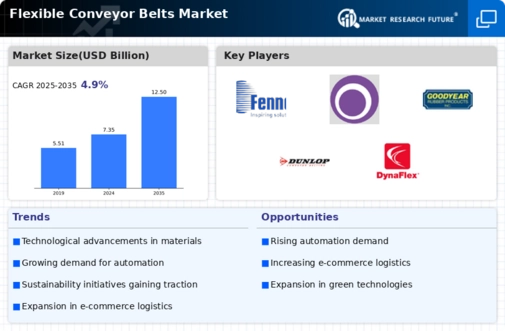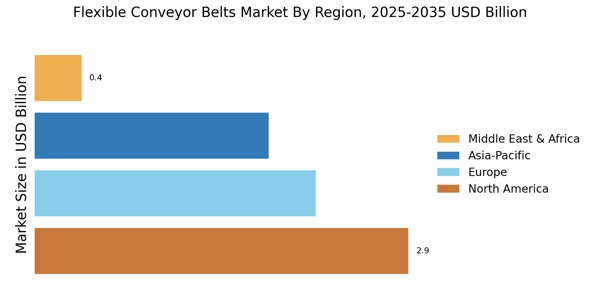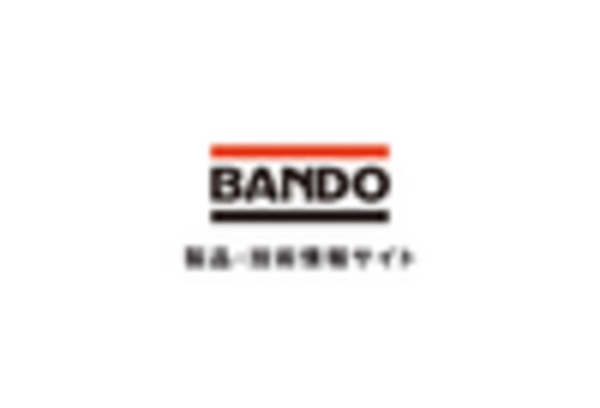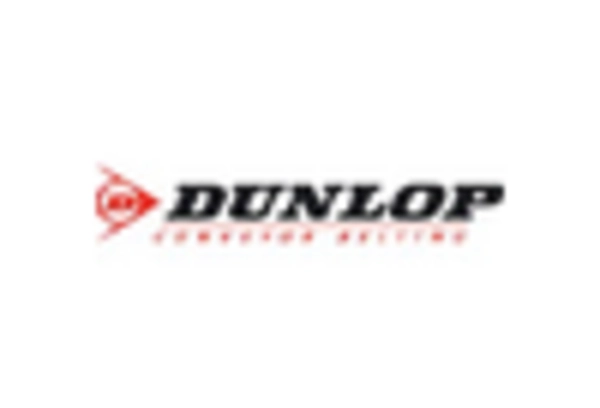Rising Demand in Manufacturing Sector
The Flexible Conveyor Belts Market is experiencing a notable surge in demand, primarily driven by the expansion of the manufacturing sector. As industries increasingly automate their processes, the need for efficient material handling solutions becomes paramount. In 2025, the manufacturing sector is projected to grow at a compound annual growth rate (CAGR) of approximately 4.5%, which directly correlates with the rising adoption of flexible conveyor belts. These belts facilitate seamless movement of goods, thereby enhancing productivity and reducing operational costs. Furthermore, the versatility of flexible conveyor belts allows them to be utilized across various manufacturing processes, from assembly lines to packaging. This adaptability is likely to bolster their market presence, as manufacturers seek to optimize their operations and improve supply chain efficiency.
Growth of E-commerce and Retail Sectors
The Flexible Conveyor Belts Market is significantly impacted by the rapid growth of the e-commerce and retail sectors. As online shopping continues to gain traction, the demand for efficient logistics and warehousing solutions is on the rise. Flexible conveyor belts play a crucial role in facilitating the swift movement of goods within distribution centers and fulfillment centers. In 2025, the e-commerce sector is projected to grow at a CAGR of approximately 6%, which will likely drive the need for advanced material handling systems. Retailers are increasingly investing in automation to meet consumer expectations for faster delivery times. Consequently, the adoption of flexible conveyor belts is expected to rise, as they provide the necessary efficiency and flexibility to handle varying product sizes and volumes.
Sustainability and Eco-friendly Practices
The Flexible Conveyor Belts Market is also witnessing a shift towards sustainability and eco-friendly practices. As environmental concerns become more pronounced, industries are seeking solutions that minimize their carbon footprint. Flexible conveyor belts made from recyclable materials and designed for energy efficiency are gaining traction. In 2025, the market for sustainable conveyor solutions is likely to expand, driven by regulatory pressures and consumer demand for greener products. Companies are increasingly adopting flexible conveyor belts that not only enhance operational efficiency but also align with their sustainability goals. This trend is expected to foster innovation in the design and manufacturing of conveyor belts, further propelling the growth of the flexible conveyor belts market.
Increased Focus on Supply Chain Efficiency
In the current landscape, the Flexible Conveyor Belts Market is significantly influenced by the heightened focus on supply chain efficiency. Companies are increasingly recognizing the importance of streamlined operations to remain competitive. The integration of flexible conveyor belts into logistics and warehousing operations is seen as a strategic move to enhance throughput and minimize delays. According to recent data, the logistics sector is expected to witness a growth rate of around 5% in 2025, further driving the demand for flexible conveyor solutions. These belts not only improve the speed of material handling but also reduce labor costs associated with manual transportation. As businesses strive to optimize their supply chains, the adoption of flexible conveyor belts is likely to become a critical component of their operational strategies.
Technological Innovations in Conveyor Systems
The Flexible Conveyor Belts Market is poised for growth due to ongoing technological innovations in conveyor systems. Advancements in materials and design are leading to the development of more durable and efficient conveyor belts. For instance, the introduction of smart conveyor systems equipped with sensors and automation capabilities is transforming traditional material handling processes. These innovations are expected to enhance the performance and reliability of flexible conveyor belts, making them more appealing to various industries. In 2025, the market for smart conveyor systems is anticipated to expand, potentially increasing the overall demand for flexible conveyor belts. As industries adopt these advanced solutions, the flexible conveyor belts market is likely to benefit from increased investment in automation and technology.


















Leave a Comment